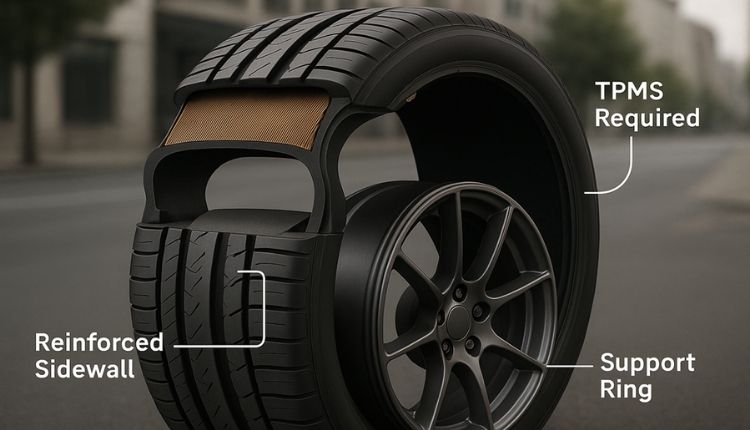Run flat tires are designed to keep you moving even after a puncture—but how exactly do they work? This article dives into the engineering, advantages, and drawbacks of run flats so buyers can make informed decisions.
The Core Concept of Run Flat Tires
Traditional tires deflate and collapse when punctured, leaving the vehicle stranded. Run flat tires, however, are built to temporarily carry the vehicle’s weight after losing air pressure. The goal is not to drive indefinitely but to give you enough time to reach a repair shop.
Most run flat tires allow you to drive up to 50 miles at speeds under 50 mph after a puncture. Some premium models can stretch to 100 miles depending on design and manufacturer guidelines.
Types of Run Flat Tire Technology
There are two primary technologies that make run flats possible:
- Self-Supporting Run Flats
- How it works: Uses reinforced, thicker sidewalls to keep the tire from collapsing when deflated.
- Advantages: Widely available, reliable under most driving conditions.
- Limitations: Stiffer ride due to rigid construction.
- Support Ring Run Flats
- How it works: A rigid rubber or composite ring inside the tire supports the vehicle’s weight when air pressure drops.
- Advantages: Provides better ride comfort compared to self-supporting models.
- Limitations: Less common, usually limited to high-end vehicles, and often more expensive.
Both designs require a Tire Pressure Monitoring System (TPMS) to alert drivers when air pressure drops. Without TPMS, it’s nearly impossible to notice a flat since the tire may appear visually normal.
The Science Behind Reinforced Sidewalls
The sidewall of a tire is normally flexible, designed to absorb shocks and provide comfort. Run flats replace this flexibility with strength. Extra layers of heat-resistant rubber and synthetic fiber reinforcement allow the sidewall to bear the vehicle’s weight, even without air pressure.
Manufacturers often use advanced materials such as aramid fibers (used in Kevlar) or specialized composites to balance durability and weight. These materials ensure that even when air escapes, the tire can still carry the vehicle without collapsing.
Bead and Rim Innovations
Another technical aspect of run flat tires lies in the bead design, which is where the tire meets the rim. Run flats often feature specially engineered beads that grip the wheel more securely, preventing the tire from unseating when deflated. This is crucial for maintaining control during sudden air loss.
Some manufacturers also integrate rim support systems that work in tandem with run flats, ensuring better stability when driving at reduced pressure.
Benefits of Run Flat Tire Technology
Safety and Control
- Tires maintain shape after a puncture, allowing controlled steering.
- Reduces the chance of dangerous blowouts at highway speeds.
Convenience
- Eliminates the need to change a tire on the roadside.
- No need to carry a spare, freeing up trunk space.
- Especially valuable in EVs where battery placement reduces storage.
Peace of Mind
- Provides assurance during late-night driving or in unsafe locations.
- Families and commuters can keep moving without immediate roadside delays.
Drawbacks of Run Flat Tires
Harsher Ride Quality
- Reinforced sidewalls reduce cushioning, making the ride firmer.
- Road noise can be louder compared to standard tires.
Higher Cost
- Typically 30–50% more expensive than conventional tires.
- Replacement options may be limited in smaller towns.
Shorter Tread Life
- Run flats often wear out 5,000–6,000 miles sooner than standard tires due to their construction.
Limited Repair Options
- Many punctures, especially on sidewalls, are non-repairable.
- Some manufacturers explicitly recommend full replacement instead of patching.
Run Flats vs. Self-Sealing Tires
While run flats are one solution for punctures, self-sealing tires are another innovation. These contain a built-in sealant layer that automatically plugs small punctures, often from nails or screws.
- Run Flats: Allow continued driving after pressure loss but still need replacement or repair soon after.
- Self-Sealing Tires: Work only for smaller punctures and may not handle larger tears, but they usually ride more comfortably than run flats.
Many drivers compare the two technologies when deciding on their next set of tires. Choosing depends on whether you value emergency mobility (run flats) or comfort and simple puncture prevention (self-sealing).
How Long Do Run Flat Tires Work After a Puncture?
- Most allow driving 50 miles at speeds under 50 mph.
- Premium run flats from certain brands extend up to 100 miles in emergency use.
- Driving beyond these limits risks damaging the wheel and compromising safety.
Fuel Economy and Efficiency
Run flats are heavier than standard tires due to extra reinforcement. This added weight can slightly reduce fuel economy. The effect is minimal for many drivers but can add up over years of use.
For EVs, reduced efficiency is a bigger concern since range anxiety is already an issue. Automakers balance this trade-off by designing EV run flats with lighter composite materials.
Vehicles Commonly Equipped with Run Flats
- Luxury cars: BMW, Lexus, Mercedes-Benz, and Audi often include them as standard.
- Sports cars: Performance models favor run flats for stability and safety.
- EVs: Many electric vehicles use run flats due to limited trunk space for spares.
- Family sedans and crossovers: Growing adoption as automakers move away from spares.
Real-World Scenarios: When Run Flats Make a Difference
- Late-night highway puncture: Instead of waiting for roadside assistance, drivers can continue to a safe location.
- Urban commutes: Flats during rush hour can be managed without blocking traffic for roadside changes.
- Rural travel: Although limited replacement availability can be a downside, the ability to reach the next town safely is an advantage.
FAQs
Q: Can I replace run flat tires with regular tires?
A: Yes, but you’ll need to carry a spare or emergency repair kit since you’ll lose run-flat capability.
Q: Do run flat tires really eliminate the need for a spare tire?
A: In many cases, yes. Automakers use run flats to save trunk space and reduce weight, especially in EVs.
Q: How do I know if my car has run flat tires?
A: Check the sidewall markings (e.g., RFT, RSC, HRS) or consult the owner’s manual.
Q: Are run flat tires safe for winter driving?
A: Only if they are winter-rated. Many run flats are summer performance tires and should not be used in snow or icy conditions.
Q: How long do run flat tires typically last compared to regular tires?
A: Run flats often last around 30,000–50,000 miles, which is slightly less than standard tires that can stretch 50,000–70,000 miles depending on care.
Key Takeaways: How Run Flats Work
- Run flats keep cars moving after a puncture using reinforced sidewalls or internal support rings.
- They offer safety and convenience but come with higher costs and firmer ride quality.
- TPMS is essential for safe use, as visual cues are not obvious.
- They’re most common in luxury, sports, and electric vehicles.
- Alternatives like self-sealing tires may suit drivers who prefer comfort.
Conclusion
Run flat tires are a fascinating blend of engineering and practicality. They let you keep driving after a puncture, offering safety and peace of mind. However, they come with trade-offs in comfort, cost, and longevity.
For city drivers, frequent highway commuters, or those with vehicles that lack a spare tire, run flats are often worth considering. But for drivers seeking maximum comfort, longer tread life, or budget-friendly options, conventional tires—or even self-sealing tires—may remain the better choice.
Always consult a trusted tire professional before making the switch to ensure compatibility with your vehicle and driving style. By understanding how run flats work and weighing the pros and cons, you’ll be better prepared to choose the right tire technology for your needs.






